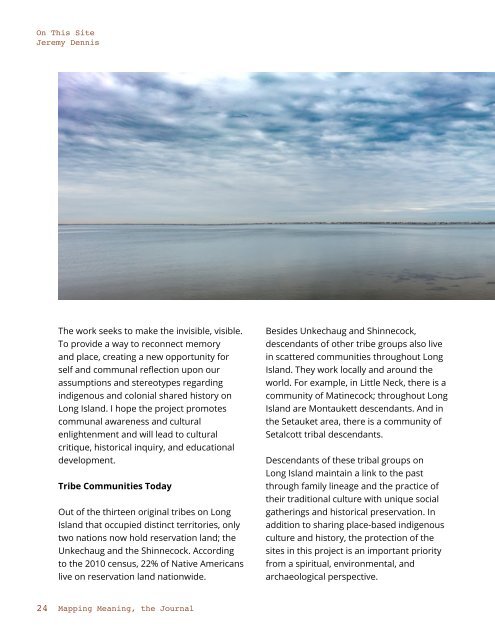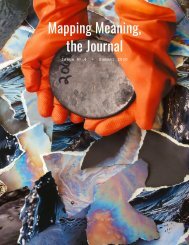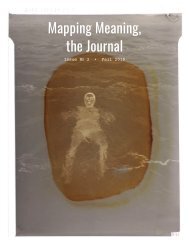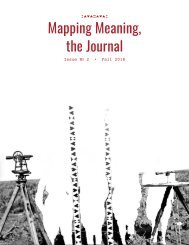Mapping Meaning, the Journal (Issue No. 1)
You also want an ePaper? Increase the reach of your titles
YUMPU automatically turns print PDFs into web optimized ePapers that Google loves.
On This Site<br />
Jeremy Dennis<br />
The work seeks to make <strong>the</strong> invisible, visible.<br />
To provide a way to reconnect memory<br />
and place, creating a new opportunity for<br />
self and communal reflection upon our<br />
assumptions and stereotypes regarding<br />
indigenous and colonial shared history on<br />
Long Island. I hope <strong>the</strong> project promotes<br />
communal awareness and cultural<br />
enlightenment and will lead to cultural<br />
critique, historical inquiry, and educational<br />
development.<br />
Tribe Communities Today<br />
Out of <strong>the</strong> thirteen original tribes on Long<br />
Island that occupied distinct territories, only<br />
two nations now hold reservation land; <strong>the</strong><br />
Unkechaug and <strong>the</strong> Shinnecock. According<br />
to <strong>the</strong> 2010 census, 22% of Native Americans<br />
live on reservation land nationwide.<br />
Besides Unkechaug and Shinnecock,<br />
descendants of o<strong>the</strong>r tribe groups also live<br />
in scattered communities throughout Long<br />
Island. They work locally and around <strong>the</strong><br />
world. For example, in Little Neck, <strong>the</strong>re is a<br />
community of Matinecock; throughout Long<br />
Island are Montaukett descendants. And in<br />
<strong>the</strong> Setauket area, <strong>the</strong>re is a community of<br />
Setalcott tribal descendants.<br />
Descendants of <strong>the</strong>se tribal groups on<br />
Long Island maintain a link to <strong>the</strong> past<br />
through family lineage and <strong>the</strong> practice of<br />
<strong>the</strong>ir traditional culture with unique social<br />
ga<strong>the</strong>rings and historical preservation. In<br />
addition to sharing place-based indigenous<br />
culture and history, <strong>the</strong> protection of <strong>the</strong><br />
sites in this project is an important priority<br />
from a spiritual, environmental, and<br />
archaeological perspective.<br />
24 <strong>Mapping</strong> <strong>Meaning</strong>, <strong>the</strong> <strong>Journal</strong>







